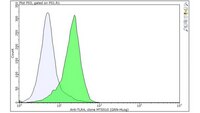Toll-like receptor 4 mediates inflammatory cytokine secretion in smooth muscle cells induced by oxidized low-density lipoprotein
Ke Yang 1 , Xiao Jie Zhang 2 , Li Juan Cao 2 , Xin He Liu 3 , Zhu Hui Liu 1 , Xiao Qun Wang 1 , Qiu Jin Chen 2 , Lin Lu 3 , Wei Feng Shen 3 , Yan Liu
Plos One
9(4)
e95935
2014
Show Abstract
Oxidized low-density lipoprotein (oxLDL)-regulated secretion of inflammatory cytokines in smooth muscle cells (SMCs) is regarded as an important step in the progression of atherosclerosis; however, its underlying mechanism remains unclear. This study investigated the role of toll-like receptor 4 (TLR4) in oxLDL-induced expression of inflammatory cytokines in SMCs both in vivo and in vitro. We found that the levels of TLR4, interleukin 1-β (IL1-β), tumor necrosis factor-α (TNFα), monocyte chemoattractant protein 1 (MCP-1) and matrix metalloproteinase-2 (MMP-2) expression were increased in the SMCs of atherosclerotic plaques in patients with femoral artery stenosis. In cultured primary arterial SMCs from wild type mice, oxLDL caused dose- and time-dependent increase in the expression levels of TLR4 and cytokines. These effects were significantly weakened in arterial SMCs derived from TLR4 knockout mice (TLR4-/-). Moreover, the secretion of inflammatory cytokines was blocked by TLR4-specific antibodies in primary SMCs. Ox-LDL induced activation of p38 and NFκB was also inhibited in TLR4-/- primary SMCs or when treated with TLR4-specific antibodies. These results demonstrated that TLR4 is a crucial mediator in oxLDL-induced inflammatory cytokine expression and secretion, and p38 and NFκB activation. | 24755612
 |
PRAT4A-dependent expression of cell surface TLR5 on neutrophils, classical monocytes and dendritic cells
Takuma Shibata 1 , Naoki Takemura, Yuji Motoi, Yoshiyuki Goto, Thangaraj Karuppuchamy, Kumi Izawa, Xiaobing Li, Sachiko Akashi-Takamura, Natsuko Tanimura, Jun Kunisawa, Hiroshi Kiyono, Shizuo Akira, Toshio Kitamura, Jiro Kitaura, Satoshi Uematsu, Kensuke Miyake
Int Immunol
24(10)
613-23
2012
Show Abstract
AbstractToll-like receptor 5 (TLR5), a sensor for bacterial flagellin, mounts innate and adaptive immune responses, and has been implicated in infectious diseases, colitis and metabolic syndromes. Although TLR5 is believed to belong to cell surface TLRs, cell surface expression has never been verified. Moreover, it has remained unclear which types of immune cells express TLR5 and contribute to flagellin-dependent responses. In this study we established an anti-mouse TLR5 monoclonal antibody and studied the cell surface expression of TLR5 on immune cells. The macrophage cell line J774 expressed endogenous TLR5 on the cell surface and produced IL-6 and G-CSF in response to flagellin. Cell surface expression of TLR5 and flagellin-induced responses were completely abolished by silencing a TLR-specific chaperone protein associated with TLR4 A (PRAT4A), demonstrating that TLR5 is another client of PRAT4A. In the in vivo immune cells, cell surface TLR5 was mainly found on neutrophils and CD11b (hi) Ly6C (hi) classical monocytes in the bone marrow, circulation, spleen and inflammatory lesions. Ly6C (hi) classical monocytes, but not neutrophils, produced cytokines in response to flagellin. Splenic CD8 (-) CD4 (+) conventional dendritic cells and CD11c (hi) CD11b (hi) lamina propria DCs, also clearly expressed cell surface TLR5. Collectively, cell surface expression of TLR5 is dependent on PRAT4A and restricted to neutrophils, classical monocytes and specific DC subsets. | 22836022
 |
Cutting edge: cell surface expression and lipopolysaccharide signaling via the toll-like receptor 4-MD-2 complex on mouse peritoneal macrophages
S Akashi 1 , R Shimazu, H Ogata, Y Nagai, K Takeda, M Kimoto, K Miyake
J Immunol
164(7)
3471-5
2000
Show Abstract
The human MD-2 molecule is associated with the extracellular domain of human Toll-like receptor 4 (TLR4) and greatly enhances its LPS signaling. The human TLR4-MD-2 complex thus signals the presence of LPS. Little is known, however, about cell surface expression and LPS signaling of the TLR4-MD-2 complex in vivo. We cloned mouse MD-2 molecularly and established a unique mAb MTS510, which reacted selectively with mouse TLR4-MD-2 but not with TLR4 alone in flow cytometry. Mouse MD-2 expression in TLR4-expressing cells enhanced LPS-induced NF-kappaB activation, which was clearly inhibited by MTS510. Thioglycolate-elicited peritoneal macrophages expressed TLR4-MD-2, which was rapidly down-regulated in the presence of LPS. Moreover, LPS-induced TNF-alpha production by peritoneal macrophages was inhibited by MTS510. Collectively, the TLR4-MD-2 complex is expressed on macrophages in vivo and senses and signals the presence of LPS. | 10725698
 |










